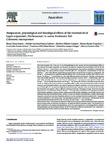Please use this identifier to cite or link to this item:
http://www.alice.cnptia.embrapa.br/alice/handle/doc/1059330Full metadata record
| DC Field | Value | Language |
|---|---|---|
| dc.contributor.author | SOARES, B. V. | pt_BR |
| dc.contributor.author | CARDOSO, A. C. F. | pt_BR |
| dc.contributor.author | CAMPOS, R. R. | pt_BR |
| dc.contributor.author | GONÇALVES, B. B. | pt_BR |
| dc.contributor.author | SANTOS, G. G. | pt_BR |
| dc.contributor.author | CHAVES, F. C. M. | pt_BR |
| dc.contributor.author | CHAGAS, E. C. | pt_BR |
| dc.contributor.author | TAVARES-DIAS, M. | pt_BR |
| dc.date.accessioned | 2016-12-27T11:11:11Z | pt_BR |
| dc.date.available | 2016-12-27T11:11:11Z | pt_BR |
| dc.date.created | 2016-12-27 | pt_BR |
| dc.date.issued | 2017 | pt_BR |
| dc.identifier.citation | Aquaculture, v. 469, p. 72-78, Feb. 2017. | pt_BR |
| dc.identifier.uri | http://www.alice.cnptia.embrapa.br/alice/handle/doc/1059330 | pt_BR |
| dc.description | This study examined the in vitro and in vivo, histopathological, anti-parasitic and hematopathological effects of the essential oil of Lippia origanoides on Colossoma macropomum. Essential oil concentrations of 10, 20, 40, 80, 160 and 320 mg·L-1 were tested in vitro against monogenoideans (Anacanthorus spathulatus, Notozothecium janauachensis and Mymarothecium boegeri) from the gills of C. macropomum. Concentrations of 320 and 160 mg·L-1 were 100% effective against these parasites within 20 and 60 min of exposure, respectively. The 80 mg·L-1 concentration was approximately 80% effective with 3 h of exposure, reaching 100% with 6 h of exposure. The 40 mg·L-1 concentration was also 100% effective with 6 h of exposure. The other concentrations were only weakly effective in vitro. Parasite mortality in controls (water or water + alcohol) began after 3 h, with 100% mortality after 8 h. In vivo tests, in which fry of C. macropomum were placed in baths with 20 mg·L-1 of the essential oil for 60 min, and 40 mg·L-1 for 30 min, did not lead to reductions in parasite abundances. In addition, the essential oil had an anaesthetic effect on fish, increased total protein levels, increased monocyte and neutrophil numbers, and reduced haematocrit. Slight to moderate and severe damage was observed in the gills of C. macropomum fingerling immediately after exposure to the essential oil, and 24 h after the treatments were applied, with no difference between treatments. Histological changes observed in the gills after exposure to concentrations of 20 and 40 mg·L-1 of L. origanoides essential oil were: hyperplasia and fusion of the lamellar epithelium, capillary dilation, displacement of the lamellar epithelium, and lamellar aneurism and epithelial rupturing with haemorrhaging. Oedema, mucous and chloride cell proliferation, lamellar hypertrophy, congestion and necrosis were less frequently observed. It can be concluded that the essential oil of L. origanoides was dose-dependent in vitro effect against monogenoidean parasites of C. macropomum. Unfortunately, the low concentrations tolerated by the fish in the vivo assay (20 and 40 mg·L-1) was not effective. Statement of relevance: The manuscript represents original research on use of the essential oil of Lippia origanoides against ectoparasites of Colossoma macropomum, an important finfish of Amazon region. This manuscript includes treatment in vitro against monogenoideans, and in vivo against protozoans and monogenoideans. Besides, histopathological and hematological analysis of the fish exposed to different concentrations of L. origanoides, a medical plant from North, Central and South America, were performed. | pt_BR |
| dc.language.iso | eng | eng |
| dc.rights | openAccess | eng |
| dc.subject | Medicinal plant | pt_BR |
| dc.subject | Parasite | pt_BR |
| dc.title | Antiparasitic, physiological and histological effects of the essential oil of Lippia origanoides (Verbenaceae) in native freshwater fish Colossoma macropomum. | pt_BR |
| dc.type | Artigo de periódico | pt_BR |
| dc.date.updated | 2017-03-31T11:11:11Z | pt_BR |
| dc.subject.thesagro | Peixe de água doce | pt_BR |
| dc.subject.thesagro | Parasito | pt_BR |
| dc.subject.thesagro | Sangue | pt_BR |
| dc.subject.thesagro | Planta medicinal | pt_BR |
| dc.subject.nalthesaurus | Freshwater fish | pt_BR |
| dc.subject.nalthesaurus | Blood | pt_BR |
| riaa.ainfo.id | 1059330 | pt_BR |
| riaa.ainfo.lastupdate | 2017-03-31 | pt_BR |
| dc.contributor.institution | BRUNA VIANA SOARES, UNIFAP; ADRIELE CAROLINA FRANCO CARDOSO, UNIFAP; ROSILENE RIBEIRO CAMPOS, UFAM; BIANCA BARATA GONÇALVES, CPAF-AP; GRACIENHE GOMES SANTOS, CPAF-AP; FRANCISCO CELIO MAIA CHAVES, CPAA; EDSANDRA CAMPOS CHAGAS, CPAA; MARCOS TAVARES-DIAS, CPAF-AP. | pt_BR |
| Appears in Collections: | Artigo em periódico indexado (CPAF-AP)  | |
Files in This Item:
| File | Description | Size | Format | |
|---|---|---|---|---|
| CPAFAP2017Antiparasiticphysiologicalandhistological.pdf | 1,63 MB | Adobe PDF |  View/Open |









